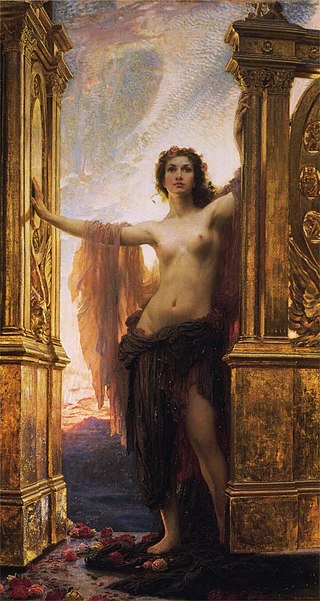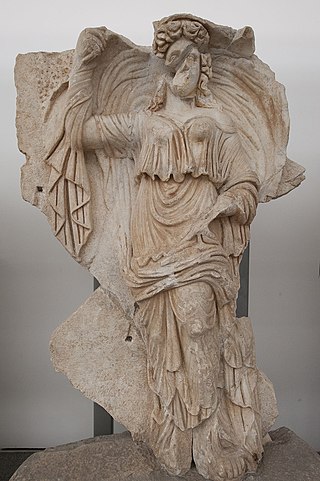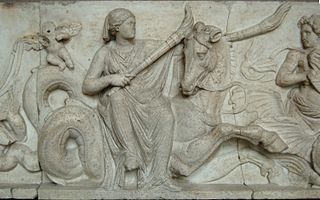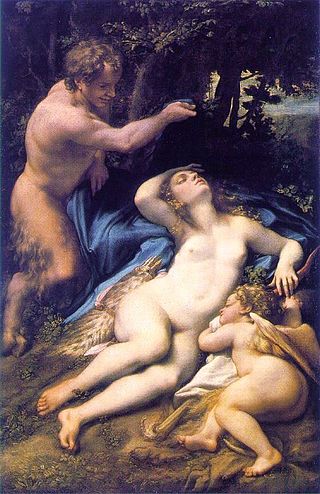
In ancient Greek mythology and religion, Eos is the goddess and personification of the dawn, who rose each morning from her home at the edge of the river Oceanus to deliver light and disperse the night. In Greek tradition and poetry, she is characterized as a goddess with a great sexual appetite, who took numerous human lovers for her own satisfaction and bore them several children. Like her Roman counterpart Aurora and Rigvedic Ushas, Eos continues the name of an earlier Indo-European dawn goddess, Hausos. Eos, or her earlier Proto-Indo-European (PIE) ancestor, also shares several elements with the love goddess Aphrodite, perhaps signifying Eos's influence on her or otherwise a common origin for the two goddesses. In surviving tradition, Aphrodite is the culprit behind Eos' numerous love affairs, having cursed the goddess with insatiable lust for mortal men.

In Greek mythology, Hypnos, also spelled Hypnus, is the personification of sleep. The Roman equivalent is Somnus. His name is the origin of the word hypnosis. Pausanias wrote that Hypnos was the dearest friend of the Muses.
In Greek mythology, Erebus, or Erebos, is the personification of darkness. In Hesiod's Theogony, he is the offspring of Chaos, and the father of Aether and Hemera (Day) by Nyx (Night); in other Greek cosmogonies, he is the father of Aether, Eros, and Metis, or the first ruler of the gods. In genealogies given by Roman authors, he begets a large progeny of personifications upon Nox, while in an Orphic theogony, he is the offspring of Chronos (Time).
In Greek mythology, Glauce, Latin Glauca, refers to different people:

In Greek mythology, Hemera was the personification of day. According to Hesiod, she was the daughter of Erebus (Darkness) and Nyx (Night), and the sister of Aether. Though separate entities in Hesiod's Theogony, Hemera and Eos (Dawn) were often identified with each other.
In Greek mythology, the Keres were female death-spirits. They were the goddesses who personified violent death and who were drawn to bloody deaths on battlefields. Although they were present during death and dying, they did not have the power to kill. All they could do was wait and then feast on the dead. The Keres were daughters of Nyx, and as such the sisters of beings such as Moirai, who controlled the fate of souls, and Thanatos, the god of peaceful death. Some later authorities, such as Cicero, called them by a Latin name, Tenebrae, and named them daughters of Erebus and Nyx.
In Greek mythology, Moros /ˈmɔːrɒs/ or Morus /ˈmɔːrəs/ is the personified spirit of impending doom, who drives mortals to their deadly fate. It was also said that Moros gave people the ability to foresee their death. His Roman equivalent was Fatum.
The following is a family tree of gods, goddesses, and other divine and semi-divine figures from Ancient Greek mythology and Ancient Greek religion.
In Greek mythology, the Hyades are a sisterhood of nymphs that bring rain.

Doris, in Greek mythology, was a sea goddess. She was one of the 3,000 Oceanids, daughters of the Titans Oceanus and Tethys.

In Greek mythology, Aether, Æther, Aither, or Ether is the personification of the bright upper sky. According to Hesiod, he was the son of Erebus (Darkness) and Nyx (Night), and the brother of Hemera (Day). In Orphic cosmogony Aether was the offspring of Chronos (Time), and the brother of Chaos and Erebus.

In Greek mythology, Philotes was a minor goddess or spirit (daimones) personifying affection, friendship, and sexual intercourse.
In Greek mythology, Oizys, or Oezys, is the personification of pain or distress. In Hesiod's Theogony, Oizys is one of the offspring of Nyx (Night), produced without the assistance of a father. Oizys has no distinct mythology of her own.

In Greek mythology, Uranus, sometimes written Ouranos, is the personification of the sky and one of the Greek primordial deities. According to Hesiod, Uranus was the son and husband of Gaia (Earth), with whom he fathered the first generation of Titans. However, no cult addressed directly to Uranus survived into classical times, and Uranus does not appear among the usual themes of Greek painted pottery. Elemental Earth, Sky, and Styx might be joined, however, in solemn invocation in Homeric epic. Uranus is associated with the Roman god Caelus.
In Greek mythology, Perse is one of the 3,000 Oceanids, water-nymph daughters of the Titans Oceanus and Tethys. Her name was also spelled as Persa, Perseide, Persea or Perseis. Perse married Helios, the god of the sun, and bore him several children, most notably the sorceress-goddess Circe.

In Roman mythology, Dies was the personification of day. She was the daughter of Chaos and Caligo (Mist), and the counterpart of the Greek goddess Hemera.

In Greek mythology, Antiope or Antiopa may refer to the following

In Greek mythology, Asteria or Asterie is a daughter of the Titans Coeus (Polus) and Phoebe and the sister of Leto. According to Hesiod, by the Titan Perses she had a single child, a daughter named Hecate, the goddess of witchcraft. Other authors made Asteria the mother of the fourth Heracles and Hecate by Zeus.
In Greek mythology, Arethusa may refer to the following personages:










